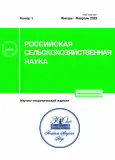Productivity of young animals of a new breed of rabbits being created
- Autores: Shumilina A.R1, Korovina E.V1, Golovanova E.V1, Tinaev N.I1, Kosovsky G.Y1
-
Afiliações:
- Scientific Research Institute of Fur Fur Breeding and Rabbit Breeding named after V.A. Afanasyev
- Edição: Nº 1 (2023)
- Páginas: 68-72
- Seção: Articles
- URL: https://journals.rcsi.science/2500-2627/article/view/144594
- DOI: https://doi.org/10.31857/S250026272301012X
- EDN: https://elibrary.ru/PEUNHW
- ID: 144594
Citar
Texto integral
Resumo
Palavras-chave
Sobre autores
A. Shumilina
Scientific Research Institute of Fur Fur Breeding and Rabbit Breeding named after V.A. Afanasyev
Email: arshumilina@mail.ru
140143, Moskovskaya obl., Ramenskii r-n, pos. Rodniki, ul. Trudovaya, 6
E. Korovina
Scientific Research Institute of Fur Fur Breeding and Rabbit Breeding named after V.A. Afanasyev140143, Moskovskaya obl., Ramenskii r-n, pos. Rodniki, ul. Trudovaya, 6
E. Golovanova
Scientific Research Institute of Fur Fur Breeding and Rabbit Breeding named after V.A. Afanasyev140143, Moskovskaya obl., Ramenskii r-n, pos. Rodniki, ul. Trudovaya, 6
N. Tinaev
Scientific Research Institute of Fur Fur Breeding and Rabbit Breeding named after V.A. Afanasyev140143, Moskovskaya obl., Ramenskii r-n, pos. Rodniki, ul. Trudovaya, 6
G. Kosovsky
Scientific Research Institute of Fur Fur Breeding and Rabbit Breeding named after V.A. Afanasyev140143, Moskovskaya obl., Ramenskii r-n, pos. Rodniki, ul. Trudovaya, 6
Bibliografia
- Глазко В.И., Косовский Г.Ю., Глазко Т.Т. Человек и доместицированные виды (обзор) // Biogeosystem Technique. 2021. № 8 (1). С. 34-44. doi: 10.13187/bgt.2021.1.34.
- Столповский Ю.А., Захаров-Гезехус И.А. Проблема сохранения генофондов доместицированных животных // Вавиловский журнал генетики и селекции. 2017. Т. 21(4) С. 477-486. doi: 10.18699/VJ17.266.
- Вализаде С.И., Гурбанова Н.Ш. Улучшение селекционных качеств стада на основе гибридов // Аграрный научный журнал. 2022. №6. С. 56-59. doi: 10.28983/asj.y2022i6pp56-59.
- Гавриленко В.П., Бушов А.В., Прокофьев А.Н. Внутрилинейный подбор и кросс линий при создании племенных стад в молочном скотоводстве // Вестник Ульяновской государственной сельскохозяйственной академии. 2018. № 4 (44). С. 140-145. doi: 10.18286/1816-4501-2018-4-140-145.
- Генетическая сочетаемость линий симментальской и красно-пестрой голштинской пород / Е.И. Анисимова, М.В. Забелина, Е.В. Радаева и др. // Аграрный научный журнал. 2022. №1. С. 47-50. doi: 10.28983/asj.y2022i1pp93-96.
- Анисимова Е.И., Катмаков П.С. Роль семейств и их сочетаемость с линиями в создании желательных типов симментальского скота // Вестник Ульяновской государственной сельскохозяйственной академии. 2017. №2 (38). С. 97-102. doi: 10.18286/1816-4501-2017-2-97-102.
- Анисимова Е.И., Катмаков П.С. Совершенствование линий симментальской породы скота Поволжья // Вестник Ульяновской государственной сельскохозяйственной академии. 2019. №2 (46). С. 155-160. doi: 10.18286/1816-4501-2019-2-155-160.
- Балакирев Н.А., Дельцов А.А., Максимов В.И. Ветеринарно-санитарная экспертиза мяса кроликов при применении препарата на основе железо-гидроксид полимальтозного комплекса // Ученые записки казанской государственной академии ветеринарной медицины им. Н.Э. Баумана. 2022. № 2. С. 17-22. doi: 10.31588/2413_4201_1883_2_250_17.
- Антипова Л.В., Попова Я.А., Черкасова А.В. Продукты из мяса кроликов для здорового питания: создание ассортиментных линеек, пищевая и биологическая ценность // Вестник Воронежского государственного университета инженерных технологий. 2019. Т. 81. №1. С.225-231.
- Economic weights in rabbit meat production / L. Cartuche, M. Pascual, E. Gómez, et al. // World Rabbit Sci. 2014. No. 22 Р. 165-177. doi.org/10.4995/wrs.2014.1747.
- Корсунь А.В., Шумилина А.Р., Куликов В.Н. Сравнительная характеристика генофонда клеточных пушных зверей и кроликов // Кролиководство и звероводство. 2021. №5. С. 24-30. doi: 10.52178/00234885_2021_5_24.
- Формирование племенного ядра крольчих новой породы на основе оценки плодовитости и популяционно-генетической структуры / А.Р. Шумилина, Е.В. Кровина, Е.В. Голованова и др. // Кролиководство и звероводство. 2021. № 6. С. 24-35.
- Соболев А.Д. Основы вариационной статистики: учебное пособие // М.: ФГОУ ВПО МГАВМиБ, 2006. 110 с.
Arquivos suplementares









